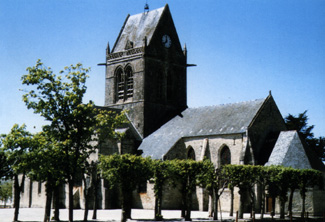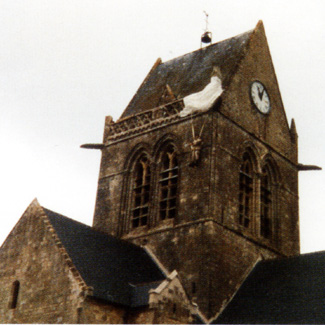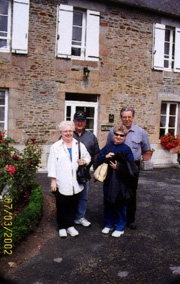|
|
|
|
|
|
|
|
|
|
|
|
|
|
|
|
|
|
|
|
|
|
|
|
|
|
|
|
|
|
|
|
|
D-Day Memorial Stories
in honor of
Maj. Norman K. Arvidson
Chapter 10
Normandy Tour — 2002
Page 4 of 4
|
|
|
|
|
 |
Left:
Our group visits a
German Bunker at
Colleville-sur-Mer
Memorial at
“Omaha Beach”
|
|
|
|
|
Utah Beach
|
|
|
|
|
|
 |
|
This was the fifth and final landing sector of D-Day, and the second American sector, but the only one situated in the department of Manche. The mission of the 7th Army Corps, commanded by General J. L. Collins, was to take the coastal positions and establish a solid bridgehead. That of the 4th Infantry Division of General R. O. Barton, whose second-in-command was General Teddy Roosevelt, was to establish themselves on the roads on the embankments above the flooded land and to link up with the 82nd and 101st Airborne Divisions parachuted after midnight over Saint - Mere - Eglise. The 101st had the task of clearing the terrain between the sea and Sainte-Mere-Eglise, while the 82nd was to take this town and the bridges over the Merderet and the Douve rivers.
|
|
|
|
|
Above:
Landing at Utah, June 6th, 1944
|
|
|
|
|
|
In order to protect Utah Beach, the American paratroopers quickly took the Varreville Dunes. Once the positions had been established, the American troops which had landed in the Utah and Omaha sectors linked up and in ten days advanced towards Cherbourg, about 30 miles away.
The Utah sector had a special role to plan in Operation Overlord. If the landing operations failed on one of these beaches or even on all, the general staff had planned to send everyone to this sector. The mission was to cut the Cotentin peninsula in two. Therefore, the Utah landing had to succeed. The landing took place at 6:30 a.m. but 1 1/4 miles further south than intended. It was the least bloody of all the five sectors, with only 200 dead, since the attack had been well prepared by aerial bombing followed by fire from the warships.
The ensemble of the sector was defended by five batteries, one of them very powerful, at Saint-Marcouf, and by a certain number of small fortifications at Saint-Martin-de-Verreville, Audouville-la-Hubert, La Madelleine, Beau Guillot and LeGrand Vey. At about 2 a.m. a thousand ships carrying 30,000 men and 3,500 vehicles approached the beaches of the eastern coast of Cotentin to play their role in the D-Day invasion.
|
|
|
|
|
Sainte-Mere-Eglise
On June 6th, at about 1 a.m., 15,000 paratroopers from the 82nd and 101st Airborne Divisions, were dropped above and around this town.
The parachute drop was not precise enough, so much so that only 6,000 soldiers were in a position to fight. Many were scattered. The furthest away landed near Barfleur, but others were drowned, tangled in their parachutes or sinking under the weight of their heavy equipment they were carrying in waters the Germans had created by flooding large areas of normally dry land.
|
|
 |
|
|
|
|
Above:
The Church of Sainte-Mere-Eglise
near “Utah Beach.”
|
|
|
|
|
By sending its reserves to look for the scattered paratroopers, the German general staff made the landing on the beach easier. The paratroopers of the 82nd Airborne were more precise than their comrades of the 101st; three quarters of them landed within a square of 3 miles. They managed to take Sainte-Mere-Eglise, defended by the 91st Division of the Luftwaffe at 4:30 a.m, that is two hours before the landing. The conquest made it possible to cut RN 13 road between Carentan and Cherbourg. The paratroopers than unhooked their comrade John Steele who was still caught by his parachute on the steeple of the church and who was wounded by German fire. These days there is a dummy figure attached to
the church to recall this event.
|
|
|
|
 |
Left:
The Bell Tower of
The Church of
Sainte-Mere-Eglise
with the dummy figure
of the American
Paratrooper whose
parachute was hung
up during his landing
attempt for the invasion.
|
|
|
|
|
|
|
|
 |
|
|
Right:
Map illustrating
the inbound route
of 82nd & 101st
U.S. Airborne Troops
and the location of
the Sainte-Mere-Eglise
community where the
church is located.
|
|
|
|
|
|
 |
|
|
|
|
|
|
|
|
|
|
Left:
Urban and Carol Otremba and
Ronn Niewohner and Jan Stay record
their final overnight stay at
the Air DeLaBaie (Inn)
at Les Veys, France.
|
|
|
|
|
End of Page 4, Chapter 10
Chapter 10, Page — 01 — 02 — 03 — 04
End of Norman Arvidson Memorial Presentation
You may go to:
Cover — Introduction — Table of Contents
Chapter — 01 — 02 — 03 — 04 — 05 — 06 — 07 — 08 — 09 — 10
Or Go To
Additional WW II, Korean War and Early Cold War
Classified Reconnaissance Recollections and Related Stories
Or
Home
|
|





